Setting the right allocation unit size for SSD can avoid space wastage and improve the utilization of SSD space, thus increasing the read and write speed of SSDs. What is the right allocation size for SSD? How do I format allocation size for SSD? Don't worry; EaseUS has provided detailed information about SSD allocation unit size.
What Is an Allocation Unit in SSD?
Allocation unit size, also referred to as "cluster size" or "block size," is the size of the blocks that a solid state drive (SSD) or hard disc drive (HDD) is divided into. This is the minimum amount of disc space required to hold a file. All file systems organize the hard disk according to the allocation unit size/cluster size.
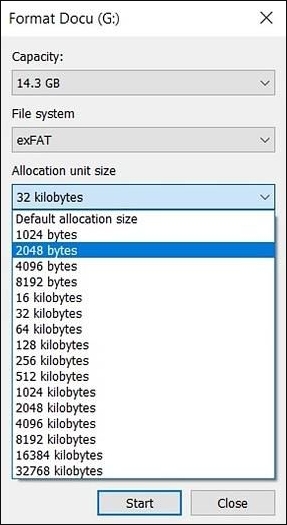
A cluster can host one file on the hard disk according to the allocation unit size. If the file size does not match the cluster size, it can lead to problems such as wasted space or delayed read-and-write performance. So, setting the optimal allocation unit size for SSD is very important. If you think this guide is useful, don't forget to share it with others in need.
What Is the Best SSD Allocation Unit Size in Windows?
So, what is the best SSD allocation unit size in Windows 10 and Windows 11? Typically, the allocation unit size of an SSD or other storage device is set by default during formatting based on the file system, disc size, and type of files stored. General:
- For small files, it is best to choose a smaller SSD cluster size.
- For large files, it is best to choose a larger SSD cluster size.
A proper SSD allocation unit size can reduce lost space: the most recommended SSD allocation unit size should be 4KB by default. Too large a unit size may result in more writes and thus wear and tear on the SSD. A gaming SSD should have a unit size of 64K. This will improve system performance and provide the fastest load times.
Therefore, we can set different views of the allocation unit size for different needs. Read on; we can manually resolve the SSD allocation unit size while formatting.
How to Set/Change SSD Allocation Unit Size?
Windows allows you to set the cluster size when formatting an SSD. If you want to change the SSD allocated unit size, this section provides the two most common ways to change and reset it:
Method 1. Set SSD Allocation Unit Size without Data Loss
In addition to reformatting your SSD, use EaseUS Partition Master Professional - a professional disk and partition management tool. It offers a Cluster Size feature to change SSD cluster size directly without losing data.
In addition, EaseUS Partition Master also provides speed test and 4K alignment features that can improve the performance of your SSD more effectively. You can choose according to your actual situation:
Option 1. Change SSD Cluster Size
Using the EaseUS Partition Master's Cluster Size feature, you can directly increase the data writing capacity and speed, especially for HDD.
Step 1. Right-click the partition that you need to change its cluster size, select "Advanced" and click "Change Cluster Size".
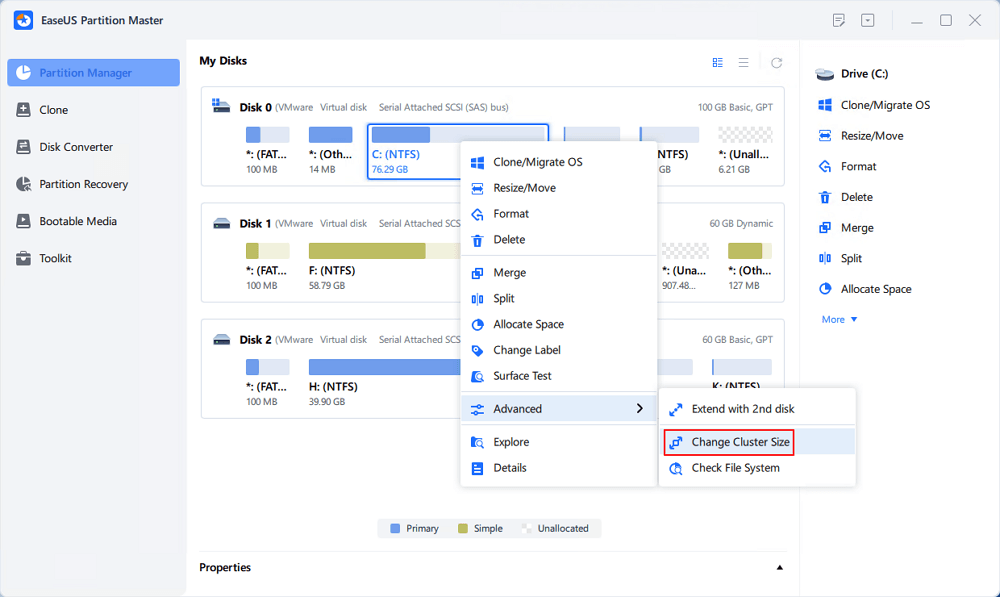
Step 2. Click the size list below the New size section, and select a desired cluster size you want to adjust for the disk partition, click "OK".
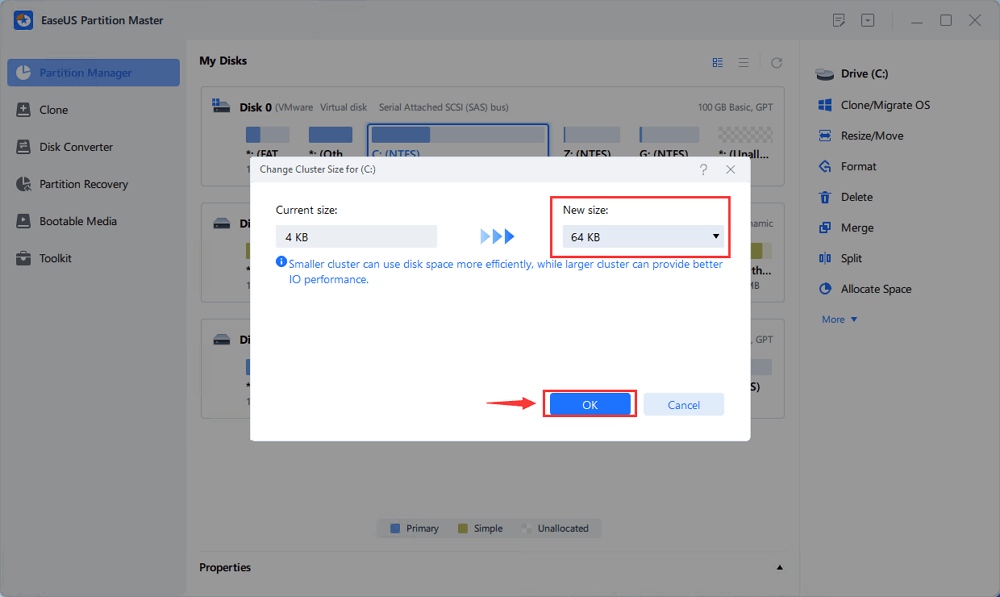
Step 3. Click "Execute 1 Task(s)" and click "Apply" to confirm the operation.
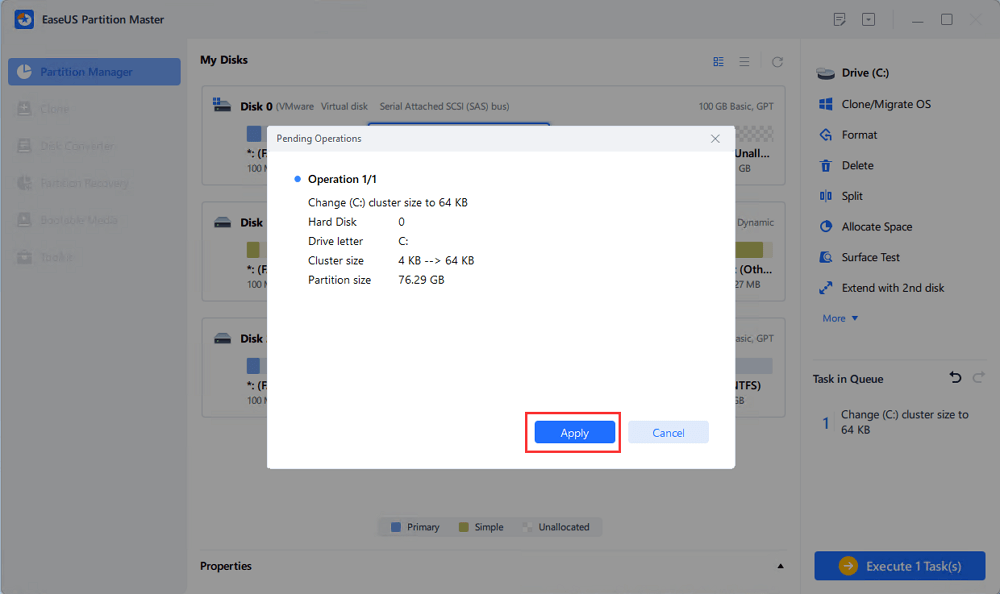
Option 2. 4K Align SSD
4K Align refers to optimizing the performance of SSDs by making them use the smallest 4K sectors in the file system to store data. This solution solves the problem of SSD cluster size without compromising the performance of the SSD and without losing data.
Step 1. Go to "Toolkit" and choose "4K Alignment".
Step 2. Select the disk you want to align. Click the "Start" button.
Method 2. Change SSD Allocation Size with Disk Management
If you don't have important data on your SSD and don't want to use a third-party tool, you can reformat your SSD and change the cluster size via Disk Management.
Step 1. To access Disk Management, right-click on the Windows icon and choose it.
Step 2. Right-click on the SSD where you want to change the cluster and select Format.
Step 3. Select the appropriate allocation unit size or file system in the Format window as required.
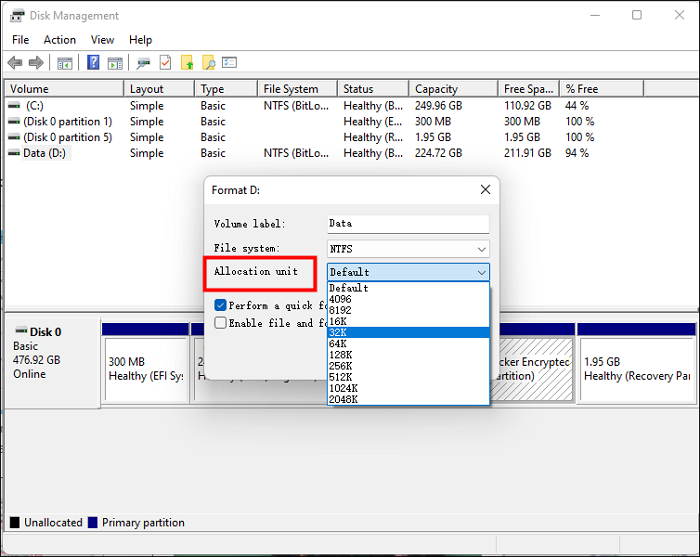
Step 4. Click OK and perform a quick format.
Conclusion
After learning this guide, we know that the best SSD allocation unit size should be 4KB, which will not cause much wear and tear on your SSD. Besides, we also guide you on two ways to change the allocation unit size SSD without losing data on Windows 11/10.
If you are looking for a safe and efficient way to set the cluster size, I highly recommend you use EaseUS Partition Master. This tool also provides more advanced features, such as converting MBR to GPT, unlocking Windows passwords, etc. Don't hesitate to download and use it.
FAQs About SSD Allocation Unit Size
After learning the best suitable SSD allocation unit size, do you have any other questions? This part provides more frequently asked questions and answers. Continue reading to solve your problem.
1. What's the best allocation unit size for gaming?
64K is the optimal allocation unit size for Windows gaming. This is because game files usually take up a lot of disc space. If you use a hard drive with a smaller cluster size to save game files, one file will take up many clusters. So, it is essential to choose the best allocation unit size for gaming.
2. What's the best allocation unit size for NTFS?
What allocation unit size should be used for NTFS flash drives depends largely on the size. If your NTFS drive is larger than 16GTB, the most appropriate allocation unit size must be 16KB. For others, such as 2GB - 2TB, the default cluster size for NTFS drives is 4KB.
3. What is the allocation unit size exFAT 256GB?
For a drive with 256GB of exFAT, 1024k is a more appropriate allocation unit size. This is ideal for large files such as videos.
Was This Page Helpful?
Cici is the junior editor of the writing team of EaseUS. She accepted the systematic training on computers at EaseUS for over one year. Now, she wrote a lot of professional articles to help people resolve the issues of hard drive corruption, computer boot errors, and disk partition problems.
Related Articles
-
How to Fix/Remove Bad Image Error Windows 10
![author icon]() Jean/2025-07-04
Jean/2025-07-04 -
macOS Sonoma Installation Failed | 4 Practical Methods to Fix it 2025
![author icon]() Brithny/2025-07-04
Brithny/2025-07-04 -
Internet Browsers Not Working after Windows Upgrade? Fix It Now!
![author icon]() Tracy King/2025-07-04
Tracy King/2025-07-04 -
7 Best Ways to Fix CD/DVD Missing or Not Showing Up in Windows 10/8/7
![author icon]() Jean/2025-07-04
Jean/2025-07-04
EaseUS Data Recovery Services
EaseUS data recovery experts have uneaqualed expertise to repair disks/systems and salvage data from all devices like RAID, HDD, SSD, USB, etc.